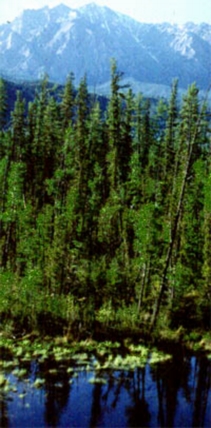

Genus: Pecea
Species: ovobata

The Pecia ovobata, or Siberian Spruce, is a tall, perennial needle-leaf tree. The Siberian Spruce is a very beautiful tree that can grow up to about 30 meters high. The trunk of this spruce is about 1.5 meters in diameter. It has slightly drooping branches that make it look like a pyramid. It has thin twigs that are yellow - green in color. The twigs are also slightly glossy. The Siberian spruce is a coniferous tree so it grows pine needles and pine cones. The needles are short from 10 - 18 mm. long and they are angular in cross section. They are a dull green color and more appressed to the upper branch. The pine cones are cylindrical and oval shaped. They are 6 - 8 cm. long and grow on ether side of the pine needles. When the pine cones are immature they are purple. When the pine cones become mature they turn brown like most pine cones.
You can find the Siberian spruce in the Siberian Taiga or Boreal forests of Siberia. The taiga is the largest biome on the earth, stretching over Eurasia and North America. It is located just below the tundra biome, near the top of the world. The Siberian Spruce makes up 5.7% of the total area of the Boreal forest.
There are extreme temperatures in the Siberian Taiga. The summers are very hot, reaching over 100 F . The winters are bitterly cold , dipping down to - 80 F. The winters are cold and lonely because all the animals are hibernating or have flown south. Only a few animals stay for the winter. There are actually only two main seasons in the taiga. They are Summer and Winter. Spring and Autumn are really short so you barely know they exist. The Siberian taiga is not an easy place for humans to live because of the weather. Most of the taigaís area is in the the watersheds of the Yenisey and Lena river systems. If you were to go the the Siberian taiga you would find yourself in a cold coniferous forest for miles!
The conical shape of the Pecia ovobata promotes shedding of snow and prevents loss of branches. The narrowness of the needles reduce surface area through which water may be lost. They also have a thick waxy coating that is water proof. This protects the needles from drying winds. The dark green color of the needles helps the foliage absorb maximum heat from the sun and begin photosynthesis sooner.
The Siberian Boreal forest is an important industry for the Russian Federation. Moose eat the twigs of trees in the Siberian taiga. Birds also eat the seeds of trees that grow in that area. The Siberian spruce and other trees in the Boreal forest have been logged since the 1950ís. The trees are being logged for money. They are also being logged to build houses.
The Pecia ovobata is not on the endangered list, but the Siberian boreal forest is. Human induced forest fires, clear cutting, air pollution and poaching are all major threats to the Siberian Taiga and the Boreal forest.
by Tessa W. 2002
Bibliography:
" Taiga." http://redbaron.bishops.ntc.nf.ca/wells/biomes/html/taiga.htm. (October 20, 2001).
"Taiga Zone" http://www.un-mongolia.mn/wildher/taiga.htm. (October 20, 2001).
"Global Environment Outlook-1.", http://www.grida.no/geo1/ch/ch2_15.htm. (October 20, 2001).
"Siberia Logging. ", http://www.american.edu/projects/mandala/TED/SIBERIA.HTM. (October 20,2001).
"Taiga or Boreal Forest" http://www.runet.edu/~swoodwar/CLASSES/GEOG235/biomes/taiga/taig a.html. (October 21,2001).
"Coniferous Species." http://www.bashedu.ru/konkurs/shakirova/conifero.htm. (January 21,2002).
"East Siberian Taiga." http://www.nationalgeographic.com/wildworld/profiles/g200/g084.html.(March 8,2002).
Krussmann, Gerd. (1983) Manual of Cultivated Conifers. Portland, Oregon: The Timber Press